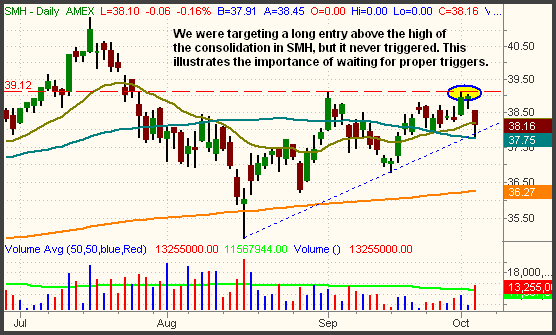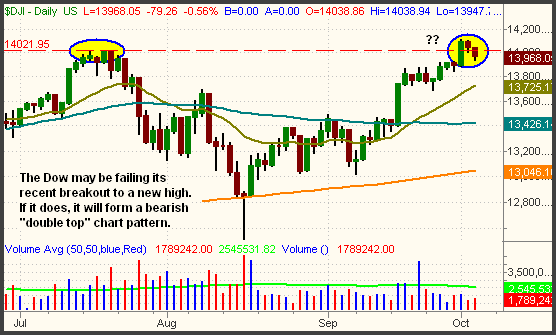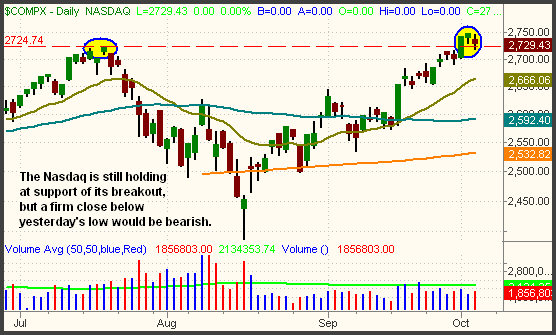|
The Wagner Daily ETF Report for October 4
After beginning the day with an opening gap down, the major indices attempted to recover throughout the morning. By mid-day, stocks had clawed their way back to nearly unchanged levels, but the bears resumed control in the afternoon. The main stock market indexes eventually closed in negative territory, in the area of their morning lows. The S&P 500 lost 0.5%, while both the Nasdaq Composite and Dow Jones Industrial Average fell 0.6%. The small-cap Russell 2000 and S&P Midcap 400 indices were lower by 0.7% and 0.3% respectively.
Turnover was mixed. Total volume in the NYSE was 2% lower than the previous day's level, but volume in the Nasdaq increased by 7%. The loss on higher volume caused the Nasdaq to register a bearish "distribution day." It was the Nasdaq's second such day of institutional selling this week. The S&P also had a "distribution day" on Monday, but dodged the label yesterday. Two recent days of higher volume selling in the Nasdaq is a warning sign to astute traders that the overall bias amongst mutual funds, hedge funds, and other institutions might be changing. Nevertheless, a healthy market can typically absorb at least three to four "distribution days" within a four-week period. A greater number nearly always marks an intermediate-term top.
In yesterday's Wagner Daily, we said we were stalking the Semiconductor HOLDR (SMH) for a potential long entry on a breakout above its consolidation. Not only did it not trade through our trigger price, the Semiconductor Index ($SOX) completely fell apart yesterday, sliding more than 2%.
Though we really liked the long setup in SMH and felt it had good odds of breaking out, yesterday's action was a clear example of how the market always does what it wants to do, not what we want it to do. This is the exact reason why we use exact trigger prices that an ETF must first exceed before we enter the position. Doing so forces the trade to confirm its own strength, rather than us simply assuming it will go. In the case of SMH, our trigger price for long entry was $39.22, ten cents above the high of the consolidation. However, it gapped down on yesterday's open, never trading above its opening high of $38.52. Had we prematurely bought SMH, we would now be looking at a loss. Instead, patience and discipline to wait for predetermined trigger prices prevented any harm from being done:

It's now pretty far away from its trigger price for entry, but SMH did manage to hold support of both its intermediate-term uptrend line and 50-day MA. Therefore, we'll continue monitoring its price action in the background to see if yesterday's action was perhaps just a "shakeout." In the interim, all bets are off in the Semiconductor arena. Anxiously "jumping the gun" to buy a stock or ETF at a "better price" than its actual pivot will only lead to churning your trading account.
Yesterday's loss in the Dow caused the index to move back below its prior high from July. Just two days ago, the blue-chip index broke out to a new all-time high, but it appears that breakout may be in jeopardy of failing. If it does, a double top will have formed in the Dow as well. With the index only slightly below support of its prior high, it's a bit too early to declare a "failed breakout," but it certainly bears watching over the next several days:

On a purely technical level, the inability of the Dow to hold at a new high is not a big deal because the index only consists of thirty stocks, none of which are stock market leaders. However, the psychological implications would be more damaging because the average investor, as well as the financial talking heads, views the Dow as a barometer of the overall stock market's health.
The Nasdaq Composite, which similarly broke out to a new multi-year high on Monday, is also in a precarious position. A firm close below yesterday's low would increase the odds of a double top formation and failed breakout in the Nasdaq as well. Notice how yesterday's low coincided with support of the prior high from July:

It's normal for an index to subsequently test new support of its breakout level, as the Nasdaq did yesterday. So far, there's no problem with the breakout. However, one might consider promptly closing any long positions in the Nasdaq if the index slips below yesterday's low. If both the Nasdaq and Dow simultaneously fail their recent breakouts and form "double tops," it's hard to imagine that sellers would not step in across the board. How aggressively they do is anyone's guess, but the reward/risk ratio would no longer favor the long side of the market.
Monday's strength caused us to stop out of our short position in the S&P 500 that day, but perhaps we were just a little too early. Many short setups will begin presenting themselves if/when the S&P, Nasdaq, and Dow fall below support of their hourly uptrend lines. A firm close below yesterday's lows would cause that to happen. At that point, moderate entries on the short side of the market, or at least closing any remaining long positions, would be the most prudent plan of action. The lack of bullish confirmation two days ago is why briefly shifted into "SOH mode," which now seems to have been wise.
Open ETF positions:
Long - LQD, MZZ
Short - (none)
Deron Wagner is the Founder and Head Trader of both Morpheus Capital LP, a U.S. hedge fund, and Morpheus Trading Group, a trader education firm launched in 2001 that provides daily technical analysis of the leading ETFs and stocks. For a free trial to the full version of The Wagner Daily or to learn about Wagner's other services, visit MorpheusTrading.com or send an e-mail to deron@morpheustrading.com.
|